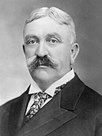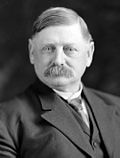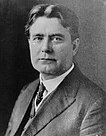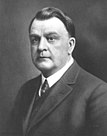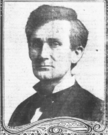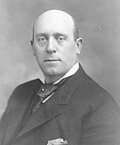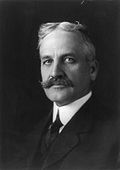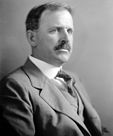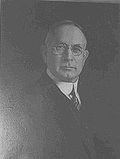1912–13 United States Senate elections
| ||||||||||||||||||||||||||||||||||
32 of the 96 seats in the United States Senate 49 seats needed for a majority | ||||||||||||||||||||||||||||||||||
|---|---|---|---|---|---|---|---|---|---|---|---|---|---|---|---|---|---|---|---|---|---|---|---|---|---|---|---|---|---|---|---|---|---|---|
| ||||||||||||||||||||||||||||||||||
 Results of the elections: Democratic gain Democratic hold Republican gain Republican hold No election | ||||||||||||||||||||||||||||||||||
| ||||||||||||||||||||||||||||||||||
The 1912–13 United States Senate elections were held on various dates in various states. They were the last U.S. Senate elections before the ratification of the Seventeenth Amendment in 1913, establishing direct elections for all Senate seats. Senators had been primarily chosen by state legislatures. Senators were elected over a wide range of time throughout 1912 and 1913, and a seat may have been filled months late or remained vacant due to legislative deadlock.[1] Some states elected their senators directly even before passage of Seventeenth Amendment. Oregon pioneered direct election and experimented with different measures over several years until it succeeded in 1907. Soon after, Nebraska followed suit and laid the foundation for other states to adopt measures reflecting the people's will. By 1912, as many as 29 states elected senators either as nominees of their party's primary or in conjunction with a general election.
In these elections, terms were up for the senators in Class 2. The Democrats gained control of the Senate for the first time in 20 years. Of the 32 seats up for election, 17 were won by Democrats, thereby gaining 4 seats from the Republicans. Two seats were unfilled by state legislators who failed to elect a new senator on time.
These elections coincided with Democrat Woodrow Wilson's victory in the presidential election amid a divide in the Republican Party. In the Senate, Joseph M. Dixon and Miles Poindexter defected from the Republican Party and joined Theodore Roosevelt's new Progressive Party. Dixon, however, lost his seat during this election.
Results summary
[edit]
| Parties | Total Seats | |||||||||
|---|---|---|---|---|---|---|---|---|---|---|
| Incumbents | This election | Result | +/- | |||||||
| Not up | Up | Re- elected | Held | Gained | Lost | |||||
| Democratic | 43 | 30 | 13 | 5 | 5 | 47 | ||||
| Republican | 52 | 33 | 19 | 6 | 4 | 45 | ||||
| Others | 0 | 0 | 0 | 0 | 0 | 0 | ||||
| Vacant | 1 | 1 | 0 | 4 | ||||||
| Total | 96 | 64 | 32 | 11 | 9 | 96 | ||||
Change in composition
[edit]Before the elections
[edit]| D1 | D2 | D3 | D4 | D5 | D6 | D7 | D8 | ||
| D18 | D17 | D16 | D15 | D14 | D13 | D12 | D11 | D10 | D9 |
| D19 | D20 | D21 | D22 | D23 | D24 | D25 | D26 | D27 Ala. Ran | D28 Ariz. New seat |
| D38 S.C. Ran | D37 Okla. Ran | D36 N.C. Ran | D35 Miss. Ran | D34 Maine (sp) Maine (reg) Ran | D33 La. Ran | D32 Ky. Retired | D31 Ga. Ran | D30 Ark. Retired | D29 Ariz. New seat |
| D39 Tex. Retired | D40 Va. (reg) Ran | D41 Va. (sp) Ran | D42 W.Va. Ran | V1 Colo. (sp) Died | V2 Ill. (sp) | R52 Wyo. Ran | R51 Tenn. Retired | R50 S.D. Ran | R49 R.I. Retired |
| Majority → | |||||||||
| R39 Mass. Retired | R40 Mich. Ran | R41 Minn. Ran | R42 Mont. Ran | R43 Neb. Ran | R44 N.H. Retired | R45 N.J. Ran | R46 N.M. (1st) New seat | R47 N.M. (1st) New seat N.M. (reg) Ran | R48 Ore. Ran |
| R38 Kan. Ran | R37 Iowa Ran | R36 Ill. Ran | R35 Idaho Ran | R34 Del. Retired | R33 Colo. Retired | R32 | R31 | R30 | R29 |
| R19 | R20 | R21 | R22 | R23 | R24 | R25 | R26 | R27 | R28 |
| R18 | R17 | R16 | R15 | R14 | R13 | R12 | R11 | R10 | R9 |
| R1 | R2 | R3 | R4 | R5 | R6 | R7 | R8 | ||
Results of elections before the next Congress
[edit]| D1 | D2 | D3 | D4 | D5 | D6 | D7 | D8 | |||
| D18 | D17 | D16 | D15 | D14 | D13 | D12 | D11 | D10 | D9 | |
| D19 | D20 | D21 | D22 | D23 | D24 | D25 | D26 | D27 Ala. Re-elected | D28 Ariz. Gain | |
| D38 Mont. Gain | D37 Miss. Hold | D36 La. Hold | D35 Ky. Hold | D34 Kan. Gain | D33 Del. Gain | D32 Colo. (sp) Gain | D31 Colo. Gain | D30 Ark. Hold | D29 Ariz. Gain | |
| D39 N.J. Gain | D40 N.C. Re-elected | D41 Okla. Re-elected | D42 Ore. Gain | D43 S.C. Re-elected | D44 Tenn. Gain | D45 Tex. Hold | D46 Va. (reg) Re-elected | D47 Va. (sp) Elected[c] | V1 Ga. D Loss | |
| Majority ↑ | ||||||||||
| R39 Neb. Hold | R40 N.M. (1st) Gain | R41 N.M. (1st) Gain N.M. (reg) Re-elected | R42 R.I. Hold | R43 S.D. Hold | R44 W.Va. Gain | R45 Wyo. Re-elected | V4 N.H. R Loss | V3 Ill. (reg) R Loss | V2 Ill. (sp) | |
| R38 Minn. Re-elected | R37 Mich. Re-elected | R36 Mass. Hold | R35
Gain | R34 Iowa Re-elected | R33 Idaho Re-elected | R32 | R31 | R30 | R29 | |
| R19 | R20 | R21 | R22 | R23 | R24 | R25 | R26 | R27 | R28 | |
| R18 | R17 | R16 | R15 | R14 | R13 | R12 | R11 | R10 | R9 | |
| R1 | R2 | R3 | R4 | R5 | R6 | R7 | R8 | |||
Beginning of the next Congress, March 4, 1913
[edit]| D1 | D2 | D3 | D4 | D5 | D6 | D7 | D8 | ||
| D18 | D17 | D16 | D15 | D14 | D13 | D12 | D11 | D10 | D9 |
| D19 | D20 | D21 | D22 | D23 | D24 | D25 | D26 | D27 | D28 |
| D38 | D37 | D36 | D35 | D34 | D33 | D32 | D31 | D30 | D29 |
| D39 | D40 | D41 | D42 | D43 | D44 | D45 | D46 | D47 | D48 |
| Majority → | D49 Ga. Appointed | ||||||||
| R39 | R40 | R41 | R42 | V4 Ill. (reg) | V3 Ill. (sp) | V2 W.Va. Seated late | P1 Wash. Changed | V1 N.H. | |
| R38 | R37 | R36 | R35 | R34 | R33 | R32 | R31 | R30 | R29 |
| R19 | R20 | R21 | R22 | R23 | R24 | R25 | R26 | R27 | R28 |
| R18 | R17 | R16 | R15 | R14 | R13 | R12 | R11 | R10 | R9 |
| R1 | R2 | R3 | R4 | R5 | R6 | R7 | R8 | ||
Beginning of the first session, April 7, 1913
[edit]| D1 | D2 | D3 | D4 | D5 | D6 | D7 | D8 | ||
| D18 | D17 | D16 | D15 | D14 | D13 | D12 | D11 | D10 | D9 |
| D19 | D20 | D21 | D22 | D23 | D24 | D25 | D26 | D27 | D28 |
| D38 | D37 | D36 | D35 | D34 | D33 | D32 | D31 | D30 | D29 |
| D39 | D40 | D41 | D42 | D43 | D44 | D45 | D46 | D47 | D48 |
| Majority → | D49 | ||||||||
| R39 | R40 | R41 | R42 | R43 Ill. (reg) Gain | R44 Ill. (sp) Gain | R45 W.Va. Seated late | P1 | D50 N.H. Gain | |
| R38 | R37 | R36 | R35 | R34 | R33 | R32 | R31 | R30 | R29 |
| R19 | R20 | R21 | R22 | R23 | R24 | R25 | R26 | R27 | R28 |
| R18 | R17 | R16 | R15 | R14 | R13 | R12 | R11 | R10 | R9 |
| R1 | R2 | R3 | R4 | R5 | R6 | R7 | R8 | ||
| Key |
|
|---|
Race summaries
[edit]Special elections during the 62nd Congress
[edit]In these special elections, the winners were seated in the 62nd Congress during 1912 or before March 4, 1913; ordered by election date.
| State | Incumbent | Results | Candidates | ||
|---|---|---|---|---|---|
| Senator | Party | Electoral history | |||
| Virginia (Class 1) | Claude A. Swanson | Democratic | 1910 (appointed) | Interim appointee elected January 23, 1912. |
|
| New Mexico (Class 1) | None (new state) | First senators elected March 27, 1912. Republican gain. |
| ||
| New Mexico (Class 2) | First senators elected March 27, 1912. Republican gain. Winner was also subsequently elected to the next term; see below. | ||||
| Arizona (Class 1) | None (new state) | First senators elected March 26, 1912, ratifying the popular selection made on December 12, 1911, state elections. Democratic gain. |
| ||
| Arizona (Class 3) | First senators elected March 26, 1912, ratifying the popular selection made on December 12, 1911, state elections. Democratic gain. |
| |||
| Maine (Class 2) | Obadiah Gardner | Democratic | 1911 (appointed) | Interim appointee elected April 2, 1912.[4] |
|
| Colorado (Class 3) | Vacant | Charles J. Hughes Jr. (D) died January 11, 1911. New senator elected January 14, 1913, ratifying the popular selection made in 1912 state elections. Democratic gain. |
| ||
| Tennessee (Class 2) | Newell Sanders | Republican | 1912 (appointed) | Interim appointee retired. New senator elected January 24, 1913. Democratic gain. Winner did not run for election to the next term; see below. |
|
| Texas (Class 2) | Rienzi Johnston | Democratic | 1913 (appointed) | Interim appointee lost election. New senator elected January 23, 1913. Democratic hold. Winner also elected to the next term; see below. |
|
| Idaho (Class 3) | Kirtland Perky | Democratic | 1912 (appointed) | Interim appointee retired. New senator elected January 24, 1913. Republican gain. |
Others
|
| Arkansas (Class 2) | John N. Heiskell | Democratic | 1913 (appointed) | Interim appointee retired. New senator elected January 27, 1913. Democratic hold. Winner did not run for election to the next term; see below. |
|
| Nevada (Class 1) | William A. Massey | Republican | 1912 (appointed) | Interim appointee lost election to finish the term. New senator elected[e] January 28, 1913, ratifying the popular selection made in 1912 state elections. Democratic gain. |
|
Races leading to the 63rd Congress
[edit]In these regular elections, the winner was seated on March 4, 1913; ordered by state.
All of the elections involved the Class 2 seats.
| State | Incumbent | Results | Candidates | ||
|---|---|---|---|---|---|
| Senator | Party | Electoral history | |||
| Alabama | John H. Bankhead | Democratic | 1907 (appointed) 1907 (special) | Incumbent had already been re-elected early January 17, 1911, for the term beginning March 4, 1913. | |
| Arkansas | John N. Heiskell | Democratic | 1913 (appointed) | Interim appointee retired. New senator elected January 29, 1913. Democratic hold. |
Others
|
| Colorado | Simon Guggenheim | Republican | 1907 | Incumbent retired. New senator elected January 14, 1913, ratifying the popular selection made in 1912 state elections.[e] Democratic gain. |
|
| Delaware | Harry A. Richardson | Republican | 1907 | Incumbent retired. New senator elected January 29, 1913. Democratic gain. |
Others
|
| Georgia | Augustus O. Bacon | Democratic | 1894 1900 1907 (appointed) 1907 (special) | Incumbent ran for re-election but the legislature failed to elect. Democratic loss. Incumbent was then appointed to begin the term.[5] | ▌Augustus O. Bacon (Democratic) |
| Idaho | William Borah | Republican | 1907 | Incumbent re-elected January 14, 1913. |
|
| Illinois | Shelby M. Cullom | Republican | 1882 1888 1894 1901 1907 | Incumbent lost renomination. Legislature failed to elect. Republican loss. A new senator was later elected; see below. |
|
| Iowa | William S. Kenyon | Republican | 1911 (special) | Incumbent re-elected January 21, 1913. |
|
| Kansas | Charles Curtis | Republican | 1907 (special) 1907 | Incumbent lost renomination.[e] New senator elected January 28, 1913, ratifying the popular selection made in 1912 state elections.[e] Democratic gain. |
|
| Kentucky | Thomas H. Paynter | Democratic | 1906 | Incumbent retired. New senator elected January 16, 1912. Democratic hold. |
|
| Louisiana | Murphy J. Foster | Democratic | 1900 1904 | Incumbent lost renomination. New senator elected May 21, 1912. Democratic hold. |
|
| Maine | Obadiah Gardner | Democratic | 1911 (appointed) 1912 (special) | Incumbent lost re-election. New senator elected January 15, 1913. Republican gain. |
|
| Massachusetts | Winthrop M. Crane | Republican | 1904 (appointed) 1905 (special) 1907 | Incumbent retired. New senator elected January 14, 1913. Republican hold. |
|
| Michigan | William A. Smith | Republican | 1911 | Incumbent re-elected January 14, 1913. |
|
| Minnesota | Knute Nelson | Republican | 1895 1901 1907 | Incumbent re-elected January 21, 1913, ratifying the popular selection made in 1912 state elections.[e] |
|
| Mississippi | LeRoy Percy | Democratic | 1910 (special) | Incumbent lost renomination. New senator elected January 16, 1912. Democratic hold. |
|
| Montana | Joseph M. Dixon | Republican | 1907 | Incumbent lost re-election as a Progressive.[e] New senator elected January 14, 1913, ratifying the popular selection made in 1912 state elections. Democratic gain. |
|
| Nebraska | Norris Brown | Republican | 1907 | Incumbent lost renomination.[17] New senator elected January 21, 1913, ratifying the popular selection made in 1912 state elections. Republican hold. |
|
| New Hampshire | Henry E. Burnham | Republican | 1901 1907 | Incumbent retired. Legislature failed to elect. Republican loss. New senator was elected late; see below. |
|
| New Jersey | Frank O. Briggs | Republican | 1907 | Incumbent lost re-election. New senator elected January 28, 1913. Democratic gain. |
|
| New Mexico | Albert B. Fall | Republican | 1912 (new state) | Incumbent re-elected June 6, 1912. Legislature invalidated the election. Incumbent then re-elected January 28, 1913. | January 28, 1913, election:
|
| North Carolina | F. M. Simmons | Democratic | 1901 1907 | Incumbent re-elected January 21, 1913. |
|
| Oklahoma | Robert L. Owen | Democratic | 1907 | Incumbent re-elected January 21, 1913.[e] |
|
| Oregon | Jonathan Bourne Jr. | Republican | 1907 | Incumbent lost renomination and then lost re-election as Popular Government candidate. New senator elected January 21, 1913, ratifying the popular selection made in 1912 state elections.[e] Democratic gain. |
|
| Rhode Island | George P. Wetmore | Republican | 1894 1900 1907 (no election) 1908 (special) | Incumbent retired. New senator elected January 21, 1913.[21] Republican hold. |
|
| South Carolina | Benjamin Tillman | Democratic | 1894 1901 1907 | Incumbent re-elected January 28, 1913. |
|
| South Dakota | Robert J. Gamble | Republican | 1901 1907 | Incumbent lost renomination.[22] New senator elected January 22, 1913. Republican hold. |
|
| Tennessee | Newell Sanders | Republican | 1912 (appointed) | Interim appointee retired. New senator elected January 23, 1913. Democratic gain. |
|
| Texas | Rienzi Johnston | Democratic | 1913 (appointed) | Interim appointee retired. New senator elected January 28, 1913. Democratic hold. |
|
| Virginia | Thomas S. Martin | Democratic | 1893 (early) 1899 (early) 1906 | Incumbent re-elected January 23, 1912. |
|
| West Virginia | Clarence W. Watson | Democratic | 1911 (special) | Incumbent lost re-election. New senator elected February 21, 1913.[24] Republican gain. Winner took seat late. |
Others
|
| Wyoming | Francis E. Warren | Republican | 1890 1893 (lost) 1895 1901 1907 | Incumbent re-elected January 28, 1913. |
|
Early election to the following Congress
[edit]In this early general election, the winner was seated in the 64th Congress, starting March 4, 1915.
| State | Incumbent | Results | Candidates | ||
|---|---|---|---|---|---|
| Senator | Party | Electoral history | |||
| Louisiana (Class 3) | John Thornton | Democratic | 1910 (special) | Incumbent retired. New senator elected early May 21, 1912. Democratic hold. |
|
Elections during the 63rd Congress
[edit]In these elections (some special, some merely late), the winners were seated in 1913 after March 4.
Some of those five elections late and some special, some by legislatures before ratification of the amendment and some popularly thereafter:
- Two elections were late and elected by legislatures: New Hampshire and Illinois (Class 2)
- One election was special and elected by a legislature: Illinois (Class 3)
- One election was late and elected popularly: Georgia
- One election was special and elected popularly: Maryland
They are ordered here by election date, then by class.
| State | Incumbent | Results | Candidates | |||||||||||||||||||||||||||||||||||||||||||||||||||||||||||||||||||||||||||||||||||||||||||||||
|---|---|---|---|---|---|---|---|---|---|---|---|---|---|---|---|---|---|---|---|---|---|---|---|---|---|---|---|---|---|---|---|---|---|---|---|---|---|---|---|---|---|---|---|---|---|---|---|---|---|---|---|---|---|---|---|---|---|---|---|---|---|---|---|---|---|---|---|---|---|---|---|---|---|---|---|---|---|---|---|---|---|---|---|---|---|---|---|---|---|---|---|---|---|---|---|---|---|---|
| Senator | Party | Electoral history | ||||||||||||||||||||||||||||||||||||||||||||||||||||||||||||||||||||||||||||||||||||||||||||||||
| New Hampshire (Class 2) | Vacant | Legislature had failed to elect in time. New senator elected late March 13, 1913 on the 43rd ballot.[25] Democratic gain. |
| |||||||||||||||||||||||||||||||||||||||||||||||||||||||||||||||||||||||||||||||||||||||||||||||
| Illinois (Class 2) | Vacant | Legislature had failed to elect in time. New senator elected late March 26, 1913. Democratic gain. |
| |||||||||||||||||||||||||||||||||||||||||||||||||||||||||||||||||||||||||||||||||||||||||||||||
| Illinois (Class 3) | Vacant | 1909 election of William Lorimer (R) was voided July 13, 1912. New senator elected March 26, 1913. Republican gain. |
| |||||||||||||||||||||||||||||||||||||||||||||||||||||||||||||||||||||||||||||||||||||||||||||||
| Elected by popular vote after ratification of the 17th Amendment | ||||||||||||||||||||||||||||||||||||||||||||||||||||||||||||||||||||||||||||||||||||||||||||||||||
| Georgia (Class 2) | Augustus O. Bacon | Democratic | 1894 1900 1907 (appointed) 1907 (special) 1913 (appointed) | Legislature had failed to elect in time, so the incumbent was appointed to begin the term. Interim appointee re-elected late June 15, 1913. |
| |||||||||||||||||||||||||||||||||||||||||||||||||||||||||||||||||||||||||||||||||||||||||||||
| Maryland (Class 1) | William P. Jackson | Republican | 1912 (appointed) | Appointee retired when elected successor qualified. New senator elected November 4, 1913 to finish the term ending March 3, 1917. Winner did not qualify until January 28, 1914.[27] Democratic gain. |
| |||||||||||||||||||||||||||||||||||||||||||||||||||||||||||||||||||||||||||||||||||||||||||||
Alabama
[edit]Incumbent Senator John H. Bankhead had already been re-elected early January 17, 1911[28] for the 1913 term.
Arkansas
[edit]One-term incumbent Senator Jeff Davis died January 3, 1913. Democratic Governor of Arkansas Joseph T. Robinson appointed John N. Heiskell January 6, 1913, to continue the term just until a special election.
Arkansas (special)
[edit]
| |||||||||||||||||
| |||||||||||||||||
| |||||||||||||||||
John N. Heiskell was not a candidate in the special election. On January 29, 1913, the Arkansas Legislature elected Democratic businessman and former judge William Marmaduke Kavanaugh just to finish the term that would end in March 1913.
|
Arkansas (regular)
[edit]
| |||||||||||||||||
| |||||||||||||||||
| |||||||||||||||||
Neither Heiskell nor Kavanaugh were candidates in the general election. On January 29, 1913, the Arkansas Legislature elected the Democratic Governor Joseph T. Robinson to the next term. This would be the last senate election by a state legislature before the April 8, 1913, adoption of the 17th amendment. Robinson would later become leader of Senate Democrats and Senate majority leader.
|
Arizona
[edit]
| ||||||||||||||||||||
| ||||||||||||||||||||
| ||||||||||||||||||||
| ||||||||||||||||||||
| ||||||||||||||||||||
| ||||||||||||||||||||
Arizona became a new state February 14, 1912, with senators in classes 1 (ending 1917) and 3 (ending 1915). For the initial senators there was a popular vote held December 12, 1911 — before statehood — and the newly formed state legislature effectively ratified the popular votes March 26, 1912: Democrat Henry F. Ashurst (class 1) and Democrat Marcus A. Smith (class 3).
Henry F. Ashurst was elected to the Territorial House of Representatives in 1897. He was re-elected in 1899, and became the territory's youngest speaker. In 1902, he was elected to the Territorial Senate. In 1911, Ashurst presided over Arizona's constitutional convention.[29] During the convention, he positioned himself for a U.S. Senate seat by avoiding the political fighting over various clauses in the constitution which damaged his rivals.[30]
| Party | Candidate | Votes | % | |
|---|---|---|---|---|
| Democratic | Henry F. Ashurst | 10,872 | 50.00% | |
| Republican | Ralph H. Cameron | 9,640 | 44.33% | |
| Socialist | E. Johnson | 1,234 | 5.68% | |
| Majority | 1,232 | 5.67% | ||
| Turnout | 21,746 | |||
Marcus A. Smith announced his candidacy for one of Arizona's two senate seats on September 24, 1911.[32] As the campaign began, Smith abandoned his long standing conservative stand and declared himself a "Progressive".[33]
| Party | Candidate | Votes | % | |
|---|---|---|---|---|
| Democratic | Marcus A. Smith | 10,598 | 50.35% | |
| Republican | Hoval A. Smith | 9,228 | 43.85% | |
| Socialist | E. B. Simonton | 1,221 | 5.80% | |
| Majority | 1,370 | 6.50% | ||
| Turnout | 21,047 | |||
With the admission of Arizona as a state in 1912, the Arizona State Legislature confirmed the selection of Smith and Ashurst as the state's first U.S. senators on March 27, 1912,[35] taking office April 2, 1912.
| Party | Candidate | Votes | % | |
|---|---|---|---|---|
| Democratic | Henry F. Ashurst | 19 | 100% | |
| Democratic | Marcus A. Smith | 19 | 100% | |
| Party | Candidate | Votes | % | |
|---|---|---|---|---|
| Democratic | Henry F. Ashurst | 35 | 100% | |
| Democratic | Marcus A. Smith | 35 | 100% | |
Colorado
[edit]On January 14, 1913, the Colorado General Assembly elected both of the state's senators: Governor John F. Shafroth for the class 2 seat (ending 1919) and Democrat Charles S. Thomas for the class 3 seat (ending 1915).
Colorado (regular)
[edit]
| |||||||||||||||||||||
| |||||||||||||||||||||
 County results Shafroth: 30–40% 40–50% 50–60% 60–70% Dawson: 30–40% 40–50% 60–70% | |||||||||||||||||||||
| |||||||||||||||||||||
One-term Republican incumbent Simon Guggenheim chose to retire in the term beginning March 4, 1913.
In the 1912 state elections, Democratic Governor of Colorado John F. Shafroth won the popular vote.
| Party | Candidate | Votes | % | |
|---|---|---|---|---|
| Democratic | John F. Shafroth | 118,260 | 47.34% | |
| Republican | Clyde Dawson | 66,949 | 26.80% | |
| Progressive | Frank Catlin | 58,649 | 23.48% | |
| Prohibition | Mary E. Miller | 5,948 | 2.38% | |
The Colorado General Assembly ratified that decision January 14, 1913, by electing Thomas.
| Party | Candidate | Votes | % | |
|---|---|---|---|---|
| Democratic | John F. Shafroth | 86 | 87.8% | |
| Republican | Clyde Dawson | 11 | 11.2% | |
| Progressive | Frank Catlin | 1 | 1.0% | |
| Democratic gain from Republican | ||||
Colorado (special)
[edit]
| |||||||||||||||||||||
| |||||||||||||||||||||
 County results Thomas: 30–40% 40–50% 50–60% 60–70% Waterman: 30–40% 40–50% 60–70% | |||||||||||||||||||||
| |||||||||||||||||||||
Democrat Charles J. Hughes Jr. (D) had died January 11, 1911, and the seat remained vacant for two years because the Colorado General Assembly failed to elect a successor.[5]
In the 1912 state elections, Democrat Charles S. Thomas (former Governor of Colorado) won the popular vote [citation needed].
| Party | Candidate | Votes | % | |
|---|---|---|---|---|
| Democratic | Charles S. Thomas | 111,633 | 44.9% | |
| Republican | Charles W. Waterman | 66,627 | 26.8% | |
| Progressive | I.N. Stevens | 64,405 | 25.9% | |
| Prohibition | Arthur B. Harris | 6,318 | 2.5% | |
The Colorado General Assembly ratified that decision January 14, 1913, by overwhelmingly voting for Thomas.
| Party | Candidate | Votes | % | |
|---|---|---|---|---|
| Democratic | Charles S. Thomas | 88 | 88.9% | |
| Republican | Waterman | 9 | 9.1% | |
| Progressive | Vincent | 1 | 1.0% | |
| Progressive | Stevens | 1 | 1.0% | |
| Democratic gain from Vacant | ||||
Delaware
[edit]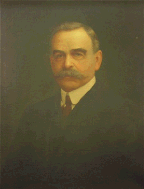
Incumbent Republican Harry A. Richardson retired after one term in office.
Democrat Willard Saulsbury Jr. had been a member of the Democratic National Committee since 1908 and had run for U.S. senator in 1899, 1901, 1903, 1905, 1907, and 1911, but Republicans controlled the state legislature and he was unsuccessful. In 1913, however, Democrats were in control of the legislature, Saulsbury was the preference of most Democrats, and he obtained the required majority January 29, 1913, after several days of balloting. This election was the first time since 1883 that a Democrat won a full term for this Senate seat in Delaware.
| Party | Candidate | Votes | % | |
|---|---|---|---|---|
| Democratic | Willard Saulsbury Jr. | 28 | 53.8% | |
| Republican | H. A. Richardson | 11 | 21.2% | |
| Republican | John G. Townsend | 5 | 9.6% | |
| Republican | Alfred I. du Pont | 3 | 5.8% | |
| Republican | Alexander P. Corbit | 3 | 5.8% | |
| Republican | Simeon S. Pennewill | 1 | 1.9% | |
| Republican | Ruby R. Vale | 1 | 1.9% | |
Georgia
[edit]
| ||||||||||||||
| ||||||||||||||
| ||||||||||||||
The Georgia General Assembly failed to elect a senator, as Democratic incumbent Augustus O. Bacon's term ended. The Governor of Georgia therefore appointed Bacon to begin the term, pending a late election.
On June 15, 1913, Bacon was elected by the general populace without opposition, becoming the first senator elected under the Seventeenth Amendment to the United States Constitution.
Bacon died in early 1914, however, leading to another interim appointment and eventual special election.
Idaho
[edit]Idaho (regular)
[edit]
| |||||||||||||||||
| |||||||||||||||||
| |||||||||||||||||
First term Republican incumbent William Borah was easily re-elected over two Democratic challengers.
| Party | Candidate | Votes | % | |
|---|---|---|---|---|
| Republican | William Borah (incumbent) | 75 | 94.9% | |
| Democratic | Kirtland I. Perky | 2 | 2.5% | |
| Democratic | George A. Tannahill | 2 | 2.5% | |
| Republican hold | ||||
Idaho (special)
[edit]
| |||||||||||||||||||||||||||||||||||||
| |||||||||||||||||||||||||||||||||||||
| |||||||||||||||||||||||||||||||||||||
Two-term incumbent Republican Weldon Heyburn died October 17, 1912. Democratic lawyer and former-Judge Kirtland I. Perky was appointed November 18, 1912, to continue the term pending a special election.
Perky was not a candidate in the special election, which was won by Republican former-Governor James H. Brady. Brady would win re-election in a popular vote in 1914.
| Party | Candidate | Votes | % | |
|---|---|---|---|---|
| Republican | James H. Brady (incumbent) | 43 | 53.8% | |
| Republican | James F. Ailshie | 7 | 8.8% | |
| Democratic | John F. Nugent | 5 | 6.3% | |
| Unknown | James E. Babb | 5 | 6.3% | |
| Unknown | Robert N. Dunn | 4 | 5.0% | |
| Unknown | E. H. Dewey | 4 | 5.0% | |
| Republican | J. T. Morrison | 3 | 3.8% | |
| Republican | Burton L. French | 2 | 2.5% | |
| Democratic | James Hanrahan | 2 | 2.5% | |
| Unknown | C. A. Beale | 1 | 1.3% | |
| Unknown | George Fields | 1 | 1.3% | |
| Unknown | J. F. Maclane | 1 | 1.3% | |
| Unknown | T. L. Burkland | 1 | 1.3% | |
| Unknown | W. C. Courtney | 1 | 1.3% | |
| Republican gain from Democratic | ||||
Illinois
[edit]In the November 1912 state elections, the Republicans lost control of the state due to the Republican / Progressive split. But while the Democrats held a plurality of the Illinois General Assembly, they did not have a majority. The General Assembly took up the matter of electing the senators on February 1. The General Assembly therefore failed to elect until after the new congress began.
On March 26, in a compromise arranged by governor Dunne, the General Assembly elected Democrat J. Hamilton Lewis to fill the full-term seat and Republican Lawrence Y. Sherman to fill the two remaining years of a vacancy that had just recently opened.
Illinois (regular)
[edit]
| |||||||||||||||||
| |||||||||||||||||
| |||||||||||||||||
On April 12, 1912, five-term Republican incumbent Shelby Moore Cullom lost renomination to Lieutenant Governor of Illinois Lawrence Y. Sherman in the Republican "advisory" primary, where the voters expressed their preference for senator but the decision was not binding on the General Assembly, which made the actual choice. Cullom had suffered politically over his support for the other Illinois senator, William Lorimer, who was embroiled in a scandal over alleged bribery in his 1909 election to the Senate.
After his defeat, Cullom withdrew his name from consideration by the General Assembly.
The Illinois General Assembly eventually elected the Democratic nominee, Congressman J. Hamilton Lewis March 26, 1913, who had also won the Democratic advisory primary, as the sole candidate on the ballot.
| Party | Candidate | Votes | % | |
|---|---|---|---|---|
| Democratic | J. Hamilton Lewis | 164 | 80.39% | |
| Progressive | Frank H. Funk | 22 | 10.78% | |
| Republican | Lawrence Y. Sherman | 9 | 4.41% | |
| Independent | Abstaining | 5 | 2.45% | |
| Socialist | Bernard Berlyn | 4 | 1.96% | |
| Democratic gain from Republican | ||||
Illinois (special)
[edit]
| |||||||||||||||||||||||||||||||||||||
| |||||||||||||||||||||||||||||||||||||
| |||||||||||||||||||||||||||||||||||||
Three months after the primary in which Sherman defeated Cullom, the U.S. Senate invalidated Lorimer's 1909 election and declared the seat vacant.[38] The Illinois Attorney General, William H. Stead determined that the General Assembly had failed to properly elect Lorimer in 1909 and so the Governor could not appoint a replacement.[39] As a result, the General Assembly had a second Senate seat to fill.
| Party | Candidate | Votes | % | |
|---|---|---|---|---|
| Republican | Lawrence Y. Sherman | 143 | 70.10 | |
| Democratic | Charles Boeschenstein | 25 | 12.26 | |
| Progressive | Frank H. Funk | 22 | 10.78 | |
| Independent | Abstaining | 9 | 4.41 | |
| Socialist | McDonald | 4 | 1.96 | |
| Democratic | John Fitzpatrick | 1 | 0.49 | |
| Republican gain from Vacant | ||||
Iowa
[edit]
| ||||||||||||||
| ||||||||||||||
| ||||||||||||||
Incumbent Republican William S. Kenyon, who had just won a 1911 special election to the seat, was easily re-elected by the Iowa General Assembly over Democratic former congressman Daniel W. Hamilton.[5]
| Party | Candidate | Votes | % | |
|---|---|---|---|---|
| Republican | William S. Kenyon (incumbent) | 29 | 61.70% | |
| Democratic | Daniel W. Hamilton | 18 | 38.30% | |
| Party | Candidate | Votes | % | |
|---|---|---|---|---|
| Republican | William S. Kenyon (incumbent) | 62 | 60.78% | |
| Democratic | Daniel W. Hamilton | 40 | 39.22% | |
| Republican hold | ||||
Kansas
[edit]
| ||||||||||||||||||||
| ||||||||||||||||||||
 County results Thompson: 30–40% 40–50% 50–60% 60–70% 70–80% Stubbs: 40–50% 50–60% 60–70% | ||||||||||||||||||||
| ||||||||||||||||||||
One-term incumbent Republican (and future Vice President) Charles Curtis lost renomination to Governor of Kansas Walter R. Stubbs, who then lost the general election to Democratic Judge William H. Thompson as Democrats took control of the Kansas Legislature in the 1912 state elections.
| Party | Candidate | Votes | % | |
|---|---|---|---|---|
| Democratic | William H. Thompson | 172,601 | 49.34% | |
| Republican | W. R. Stubbs | 151,647 | 43.35% | |
| Socialist | Allan W. Ricker | 25,610 | 7.32% | |
| Total votes | 349,858 | 100.00% | ||
| Party | Candidate | Votes | % | |
|---|---|---|---|---|
| Democratic | William H. Thompson | 40 | 100% | |
| Turnout | 40 | 100.0% | ||
| Party | Candidate | Votes | % | |
|---|---|---|---|---|
| Democratic | William H. Thompson | 120 | 96.8% | |
| Republican | W. R. Stubbs | 3 | 2.4% | |
| Progressive | Henry J. Allen | 1 | 0.8% | |
| Turnout | 124 | 99.2% | ||
| Democratic gain from Republican | ||||
Thompson would only serve one term, losing re-election in 1918. As of 2023, this is the last time the Democrats won the Class 2 Senate seat in Kansas. This represents the longest current winning streak of either party for a single Senate seat.
Curtis' political career, meanwhile, would rebound, as he was elected to Kansas' other US Senate seat, first by defeating Kansas' senior senator Joseph L. Bristow in the Republican primary, and then winning re-election nonconsecutively to the U.S Senate by a very narrow margin over two opponents, becoming the first Kansan to be popularly elected to the U.S Senate in a historic first. Curtis would serve in the Senate for three terms before resigning to become U.S. Vice President in March 1929, the first Native American to serve in that office.
Kentucky
[edit]
| |||||||||||||||||
| |||||||||||||||||
Blue denotes members voting for James and red denotes those voting for Morrow. | |||||||||||||||||
| |||||||||||||||||
One-term Democrat Thomas H. Paynter retired and Democratic Representative Ollie James was easily elected January 16, 1912.[2]
| Party | Candidate | Votes | % | |
|---|---|---|---|---|
| Democratic | Ollie James | 31 | 88.6% | |
| Republican | Edwin P. Morrow | 4 | 11.4% | |
| Party | Candidate | Votes | % | |
|---|---|---|---|---|
| Democratic | Ollie James | 74 | 75.5% | |
| Republican | Edwin P. Morrow | 24 | 24.6% | |
The legislature formally elected James a second time January 16, 1912, to comply with a federal rule requiring an election on the second Tuesday after the meeting of the legislature.[2]
Louisiana
[edit]Class 2: starting March 4, 1913
Class 3: starting March 4, 1915
Louisiana held two elections May 21, 1912: an election for the class 2 term that would begin March 4, 1913, and an election for the class 3 term that would begin March 4, 1915.
Louisiana (regular, class 2)
[edit]In the class 2 seat, Democrat Murphy J. Foster lost renomination to fellow-Democrat Joseph E. Ransdell, who later was elected unopposed to seat.
Louisiana (regular, class 3)
[edit]In the class 3 seat, Democrat John Thornton retired. Fellow-Democrat Robert F. Broussard was elected unopposed, but he would have to wait until term began on March 4, 1915.
Maine
[edit]Five-term incumbent Republican William P. Frye had died August 8, 1911, and Democrat Obadiah Gardner was appointed September 23, 1911, to continue the term, pending a special election. In this election cycle, Gardner would first win the election to finish the term and then lose re-election to the next term.
Maine (special)
[edit]
| |||||||||||||||||
| |||||||||||||||||
| |||||||||||||||||
Democratic interim appointee Obadiah Gardner was elected April 2, 1912, to finish the term ending March 3, 1913.[4][2]
| Party | Candidate | Votes | % | |
|---|---|---|---|---|
| Democratic | Obadiah Gardner (incumbent) | 20 | 76.9% | |
| Republican | Frederick A. Powers | 6 | 23.1% | |
| Party | Candidate | Votes | % | |
|---|---|---|---|---|
| Democratic | Obadiah Gardner (incumbent) | 78 | 60.9% | |
| Republican | Frederick A. Powers | 50 | 39.1% | |
| Democratic hold | ||||
Maine (regular)
[edit]
| |||||||||||||||||
| |||||||||||||||||
| |||||||||||||||||
Democrat Obadiah Gardner lost re-election January 15, 1913, to Republican Edwin C. Burleigh for the term starting March 4, 1913.
"There was no choice in the separate balloting on January 14. The next day in joint assembly, [Burleigh was elected]."[14]
| Party | Candidate | Votes | % | |
|---|---|---|---|---|
| Republican | Edwin C. Burleigh (incumbent) | 91 | 50.6% | |
| Democratic | Obadiah Gardner | 82 | 45.6% | |
| Progressive | E.M. Thompson | 7 | 3.9% | |
| Republican gain from Democratic | ||||
Maryland (special)
[edit]
| |||||||||||||||||
| |||||||||||||||||
 County results Parran: 40–50% 50–60% 60–70% Lee: 30–40% 40–50% 50–60% 60–70% 70–80% | |||||||||||||||||
| |||||||||||||||||
Democrat Isidor Rayner died November 25, 1912, and Republican William P. Jackson was appointed to continue the term, pending a special election.
Democratic state senator Blair Lee was elected November 4, 1913.
| Party | Candidate | Votes | % | ||
|---|---|---|---|---|---|
| Democratic | Blair Lee | 112,485 | 56.75% | ||
| Republican | Thomas Parran Sr. | 73,300 | 36.98% | ||
| Progressive | George Wellington | 7,033 | 3.55% | ||
| Socialist | Robert Fields | 2,982 | 1.5% | ||
| Prohibition | Finley Hendrickson | 2,405 | 1.21% | ||
| Turnout | 198,205 | ||||
| Democratic gain from Republican | |||||
Lee presented his credentials to serve as senator on December 5, 1913, but he did not qualify until January 28, 1914, because Jackson claimed that "since [Jackson] had been appointed under the original constitutional provision, [Jackson] was entitled to hold his seat until the regularly scheduled adjournment date of the Maryland state assembly."[27] The Senate considered Jackson's challenge but eventually rejected it and seated Lee.
Lee would only serve this one term, as he lost renomination in 1916.
Massachusetts
[edit]
| |||||||||||||||||
| |||||||||||||||||
| |||||||||||||||||
Republican Winthrop M. Crane, who was first appointed in 1904, retired. Republican congressman from Newton, Massachusetts, John W. Weeks, was elected January 14, 1913, to succeed him. Republican Eben Sumner Draper had been considered a candidate for the seat, but the Republican party, then under the control of its hardline conservative faction (and in control of the legislature), chose Weeks instead.[43]
| Party | Candidate | Votes | % | |
|---|---|---|---|---|
| Republican | John W. Weeks | 97 | 60.25% | |
| Republican | Samuel Walker McCall | 57 | 35.40% | |
| Republican | Curtis Guild Jr. | 5 | 3.11% | |
| Republican | George P. Lawrence | 1 | 0.62% | |
| Republican | Robert Luce | 1 | 0.62% | |
| Total votes | 161 | 100.00% | ||
| Party | Candidate | Votes | % | |
|---|---|---|---|---|
| Republican | John W. Weeks | 26 | 66.67% | |
| Democratic | Sherman L. Whipple | 11 | 28.21% | |
| Democratic | John A. Keliher | 1 | 2.56% | |
| Democratic | Joseph C. Pelletier | 1 | 2.56% | |
| Party | Candidate | Votes | % | |
|---|---|---|---|---|
| Republican | John W. Weeks | 134 | 57.51% | |
| Democratic | Sherman L. Whipple | 69 | 29.61% | |
| Progressive | John Graham Brooks | 5 | 2.15% | |
| Democratic | John F. Meaney | 3 | 1.29% | |
| Democratic | James B. Carroll | 3 | 1.29% | |
| Democratic | Charles A. DeCourey | 3 | 1.29% | |
| Democratic | Charles Sumner Hamlin | 2 | 0.86% | |
| Democratic | John A. Thayer | 2 | 0.86% | |
| Democratic | John F. Fitzgerald | 2 | 0.86% | |
| Republican | Curtis Guild Jr. | 1 | 0.43% | |
| Republican | Robert Luce | 1 | 0.43% | |
| Democratic | Philip J. O'Connell | 1 | 0.43% | |
| Unknown | Olney | 1 | 0.43% | |
| Democratic | Joseph Henry O'Neil | 1 | 0.43% | |
| Unknown | Peters | 1 | 0.43% | |
| Unknown | Pratt | 1 | 0.43% | |
| Unknown | Sawyer | 1 | 0.43% | |
| Unknown | Sweeney | 1 | 0.43% | |
| Unknown | Williams | 1 | 0.43% | |
Weeks would only serve for one six-year term. He would lose re-election in 1918 to Democrat David I. Walsh.
Michigan
[edit]
Two-term Republican William A. Smith, whose Senate tenure began weeks before his first full-term began, was re-elected January 14, 1913.
 William A. Smith (Republican) 74 votes
William A. Smith (Republican) 74 votes- Alfred Lucking (Democratic) 41 votes
- Theodore Joslin (Progressive) 17 votes[14]
He would retire after this term.
Minnesota
[edit]

Nelson: 50–60% 60–70% 70–80% 80–90%
Lawler: 50–60% 60–70%
Three-term Republican Knute Nelson was overwhelmingly supported in a 1912 popular election.
 Knute Nelson (Republican) 62.80%
Knute Nelson (Republican) 62.80%- Daniel W. Lawler (Democratic) 37.21%[15]
The Minnesota Legislature unanimously ratified the popular vote January 21, 1913:
- Minnesota Senate:
 Knute Nelson (Republican) 61 votes (Unanimous)
Knute Nelson (Republican) 61 votes (Unanimous) - Minnesota House of Representatives:
 Knute Nelson (Republican) 117 votes (Unanimous)
Knute Nelson (Republican) 117 votes (Unanimous)
Nelson later would be re-elected again in 1918 to a fifth term, before his 1923 death.
Mississippi
[edit]
| |||||||||||||||||||||||||||||||||||||
| |||||||||||||||||||||||||||||||||||||
 County results Vardaman: 30-40% 40-50% 50-60% 60-70% 70-80% Percy: 40-50% 50-60% 60-70% 70-80% | |||||||||||||||||||||||||||||||||||||
| |||||||||||||||||||||||||||||||||||||
One-term Democrat LeRoy Percy lost renomination in mid-1911 to white supremacist James K. Vardaman, who was then elected January 16, 1912, to the seat, unopposed.[2]
Percy had won in 1910 (to finish a vacant term) despite Vardaman's support of a plurality of legislators (all white). The fractured remainder sought to thwart his extreme racial policies. A majority united behind Percy to block Vardaman's election. Percy had advocated education for blacks and worked to improve race relations by appealing to the planters' sense of noblesse oblige. Disenfranchisement of blacks made the Democratic primary the deciding competitive race for state and local offices in Mississippi.
In this rematch, Vardaman's campaign was managed by Lieutenant Governor of Mississippi (and future senator) Theodore Bilbo, who emphasized class tensions and racial segregation, attacking Percy as a representative of the aristocracy of the state and for taking a progressive stance on race relations.
Vardaman, however, would only serve one term, losing renomination in 1918, primarily due to his vote against entry into World War I.
| Candidate | Votes | % |
|---|---|---|
| James K. Vardaman | 79,380 | 60.04 |
| C. H. Alexander | 31,300 | 23.68 |
| LeRoy Percy | 21,521 | 16.28 |
| Total | 132,201 | 100.00 |
| Source: [46] | ||
Montana
[edit]

Walsh: 30–40% 40–50% 50–60%
Dixon: 30–40% 40–50% 50–60%
Smith: 40–50%
No Vote:
One-term Republican Joseph M. Dixon ran for re-election as a Progressive, but lost to Democrat Thomas J. Walsh.
| Party | Candidate | Votes | % | |
|---|---|---|---|---|
| Democratic | Thomas J. Walsh | 28,421 | 41.17% | |
| Progressive | Joseph M. Dixon (Incumbent) | 22,161 | 32.10% | |
| Republican | Henry C. Smith | 18,450 | 26.73% | |
The Montana Legislature then unanimously elected Walsh January 14, 1913.[14]
Walsh would be re-elected four more times and serve for 20 years until his 1933 death. Dixon, meanwhile, would go on to become Governor of Montana from 1921 to 1925.
Nebraska
[edit]
First-term Republican Norris Brown lost renomination to George W. Norris, who was then elected January 21, 1913.
| Party | Candidate | Votes | % | |
|---|---|---|---|---|
| Democratic | Ashton C. Shallenberger | 27,581 | 57.61% | |
| Democratic | William H. Thompson | 11,993 | 25.05% | |
| Democratic | Willis E. Reed | 5,244 | 10.95% | |
| Democratic | Robert F. Smith | 3,061 | 6.39% | |
| Party | Candidate | Votes | % | |
|---|---|---|---|---|
| Republican | George W. Norris | 38,893 | 53.98% | |
| Republican | Norris Brown (Incumbent) | 33,156 | 46.02% | |
| Party | Candidate | Votes | % | |
|---|---|---|---|---|
| Republican | George W. Norris | 126,022 | 52.96% | |
| Democratic | Ashton C. Shallenberger | 111,946[48] | 47.04% | |
Despite the Democratic majority, the Nebraska legislature elected Republican Norris unanimously, upholding the popular vote.[49]
"The Democratic Legislature will be called upon to elect a Republican for United States Senator. Ninety-five per cent. [sic] of the candidates for the Legislature, in accordance with the Oregon plan, signed "Statement No. 1," which provides that, in the event of election, they will vote for the candidate for United States Senator who obtains the preference vote of the people. Although Congressman Norris, a Progressive Republican, has won the preference vote, returns indicate that a Democratic legislature has been elected."[50]
Norris would serve for thirty years, winning two more elections as a Republican and one as an Independent but losing re-election in 1942.
Nevada (special)
[edit]

Pittman: 30–40% 40–50% 50–60%
Massey: 30–40% 40–50% 50–60%
Republican senator George S. Nixon died June 5, 1912. Republican former-judge William A. Massey was appointed July 1, 1912, to continue the term that would end in 1917, pending a special election. In November 1912, Massey lost the popular vote for the special election to Democratic attorney Key Pittman was elected by the Nevada Legislature January 28, 1913.
| Party | Candidate | Votes | % | |
|---|---|---|---|---|
| Democratic | Key Pittman | 7,942 | 39.78% | |
| Republican | William A. Massey (Incumbent) | 7,853 | 39.34% | |
| Socialist | George A. Steele | 2,740 | 13.73% | |
| Progressive | Sardis Summerfield | 1,428 | 7.15% | |
Pittman had a small plurality in the November 1912 popular vote, but the legislature elected him almost unanimously.
| Party | Candidate | Votes | % | |
|---|---|---|---|---|
| Democratic | Key Pittman | 20 | 90.9% | |
| Socialist | George A. Steele | 2 | 9.1% | |
| Party | Candidate | Votes | % | |
|---|---|---|---|---|
| Democratic | Key Pittman | 50 | 98.0% | |
| Socialist | George A. Steele | 1 | 2.0% | |
| Democratic gain from Republican | ||||
Massey died the next year, and Pittman would go on to serve for 27 more years and win re-election four times, serving as President pro tempore throughout the New Deal.
New Hampshire
[edit]
| |||||||||||||||||
| |||||||||||||||||
| |||||||||||||||||
Two-term Republican Henry E. Burnham decided to retire. The New Hampshire legislature failed to elect a new senator after 42 votes, so the March 4, 1913, term begin with the seat vacant.
Finally, on March 26, 1913, on the 43rd vote, Democrat Henry F. Hollis was elected with the required majority, albeit slight. Hollis was a former candidate for U.S. House of Representatives (in 1900), and twice for Governor of New Hampshire (in 1902 and 1904).
| Party | Candidate | Votes | % | |
|---|---|---|---|---|
| Democratic | Henry F. Hollis | 189 | 50.94% | |
| Republican | John H. Bartlett | 121 | 32.62% | |
| Republican | Henry B. Quinby | 18 | 4.85% | |
| Republican | Edward N. Pearson | 14 | 3.77% | |
| Progressive | Robert P. Bass | 12 | 3.24% | |
| Republican | Sherman E. Burroughs | 5 | 1.35% | |
| Democratic | Gordon Woodbury | 3 | 0.81% | |
| Democratic | Clarence E. Carr | 2 | 0.54% | |
| Unknown | William D. Swart | 2 | 0.54% | |
| Republican | Thomas Chalmers | 1 | 0.27% | |
| Republican | William Eaton Chandler | 1 | 0.27% | |
| Republican | John Scammon | 1 | 0.27% | |
| Unknown | Bertram Ellis | 1 | 0.27% | |
| Unknown | Henry C. Wells | 1 | 0.27% | |
| Democratic gain from Republican | ||||
Hollis would retire after a single term and be replaced, in a popular vote, by Republican Henry W. Keyes.
New Jersey
[edit]
One-term incumbent Republican Frank O. Briggs lost re-election to Democratic state judge (and former member of the U.S. House) William Hughes. The New Jersey Legislature elected Hughes January 28, 1913.
| Party | Candidate | Votes | % | |
|---|---|---|---|---|
| Democratic | William Hughes | 12 | 57.14% | |
| Republican | Frank O. Briggs (Incumbent) | 9 | 42.86% | |
| Party | Candidate | Votes | % | |
|---|---|---|---|---|
| Democratic | William Hughes | 51 | 86.44% | |
| Republican | Frank O. Briggs (Incumbent) | 8 | 13.56% | |
| Party | Candidate | Votes | % | |
|---|---|---|---|---|
| Democratic | William Hughes | 63 | 78.75% | |
| Republican | Frank O. Briggs (Incumbent) | 17 | 21.25% | |
| Democratic gain from Republican | ||||
Briggs, died just a few months later on May 8, 1913. Hughes would not serve the complete term, dying January 30, 1918, just before the next scheduled election.
New Mexico
[edit]New Mexico (initial)
[edit]

New Mexico became a new state January 6, 1912, with senators in classes 1 (ending 1917) and 2 (ending 1913). On March 27, 1912, the state elected its initial senators on the eighth ballot:[54] Republican Thomas B. Catron, an early advocate for New Mexico statehood who had marshaled the territorial Republican Party to lobby Republicans at the national level for New Mexico's admission to the Union,[55][56][57] and Republican Albert B. Fall, a powerful attorney, former territorial attorney general, future Secretary of the Interior, and instigator of the Teapot Dome scandal)
Catron made a personal alliance with Fall, ensuring that each of them would be elected. This alliance antagonized New Mexicans of Spanish heritage, who had hoped that one of their own would become a Senator.[58]
|
New Mexico (regular)
[edit]Fall's term would end in March 1913, so he was up for re-election shortly after his initial term began.
The bitterness over Catron and Fall's alliance made Fall a target of the local Republican Party, as they believed Fall had not contributed sufficiently to their efforts to secure New Mexico's statehood, and was not worthy of their nomination. The selection of Catron and Fall also disappointed Hispanics, who had hoped that one of their own would be selected. Fall was also severely disliked by Democrats.
After various votes, the legislature re-elected Fall January 28, 1913. Governor McDonald, on the advice of his Democratic legal advisor, Summers Burkhart, said that the legislature's procedure had been illegal, and failed to sign the credentialing papers in an attempt to oust Fall by forcing a special session of the legislature and a new vote.[59] The attempt failed; Fall won the special legislative election.[60]
North Carolina
[edit]
Simmons: 40–50% 50–60% 60–70% 70–80% 80–90%
Kitchin: 40–50% 50–60% 60–70% 70–80% 80–90% >90%
Clark: 30–40% 40–50%
No Vote:

Two-term Democrat Furnifold Simmons was easily re-elected January 21, 1913. Simmons was a staunch segregationist, white supremacist and a leading perpetrator of the Wilmington insurrection of 1898.
| Party | Candidate | Votes | % | |
|---|---|---|---|---|
| Democratic | Furnifold Simmons (Incumbent) | 84,687 | 57.18% | |
| Democratic | William W. Kitchin (Governor) | 47,010 | 31.74% | |
| Democratic | Walter Clark (State judge) | 16,418 | 11.09% | |
| Party | Candidate | Votes | % | |
|---|---|---|---|---|
| Democratic | Furnifold Simmons (Incumbent) | 144 | 88.34% | |
| Republican | Cyrus Thompson (N.C. Secretary of State) | 19 | 11.66% | |
Simmons would be re-elected twice more after this and serve until 1931, when he fell out with the national Democratic Party.
Oklahoma
[edit]

Owen: 30–40% 40–50% 50–60% 60–70%
Dickerson: 40–50% 50–60%
One term Democrat Robert L. Owen was re-elected over token opposition from Governor of Oklahoma Charles N. Haskell in the Democratic primary and perennial Republican candidate Joseph Dickerson.
| Party | Candidate | Votes | % | |
|---|---|---|---|---|
| Democratic | Robert L. Owen (Incumbent) | 80,204 | 64.32% | |
| Democratic | Charles N. Haskell | 44,483 | 35.68% | |
| Turnout | 7.52% | |||
| Party | Candidate | Votes | % | |
|---|---|---|---|---|
| Democratic | Robert L. Owen (Incumbent) | 126,418 | 50.43% | |
| Republican | Joseph Dickerson | 83,429 | 33.28% | |
| Socialist | John Wills | 40,860 | 16.3% | |
| Turnout | 15.13% | |||
Owen was formally and unanimously elected by the Oklahoma Legislature January 21, 1913.[64][14]
Owen would run for U.S. president (failing to achieve his party's nomination), and then serve a third and final term as the young state's initial Class 2 senator, retiring in 1925.
Oregon
[edit]

Lane: 20–30% 30–40%
Selling: 20–30% 30–40% 40–50%
Bourne: 30–40%
One-term Republican Jonathan Bourne Jr. had championed direct-election of senators but lost renomination as a Republican. He then ran in the popular election as a "Popular Government" candidate, but also lost re-election. Democratic Mayor of Portland Harry Lane was elected.
The ballot was cluttered. In addition to the Lane and Ben Selling, candidate of the conservative wing of the Republican Party, progressive Republicans had other electoral alternatives, including the candidate and the incumbent senator Jonathan Bourne Jr., who had failed to win the renomination of the Republican party and ran as the "Popular Government" nominee as a result. Meanwhile, Benjamin F. Ramp stood for the Socialists and yet another candidate was the nominee of the Prohibition Party.[65] Each of these six candidates took more than 5% of the vote — a fact which enabled the Lane to win election with a plurality of the vote in solidly Republican Oregon.[65] Intent on proving himself a man of the people, Harry Lane set what might be a record for campaign frugality in his victorious effort, with his entire race run for $75 plus travel expenses.[66]
| Party | Candidate | Votes | % | |
|---|---|---|---|---|
| Democratic | Harry Lane | 40,172 | 30.07% | |
| Republican | Ben Selling | 38,453 | 28.79% | |
| Popular Government | Jonathan Bourne Jr. (Incumbent) | 25,929 | 19.41% | |
| Socialist | Benjamin F. Ramp | 11,093 | 8.31% | |
| Progressive | A. E. Clark | 11,083 | 8.30% | |
| Prohibition | B. Lee Paget | 6,848 | 5.13% | |
| Democratic gain from Republican | ||||
The Oregon Legislature thereupon elected Lane to the seat January 21, 1913,[14] ratifying the popular selection made in the November 1912 elections.
| Party | Candidate | Votes | % | |
|---|---|---|---|---|
| Democratic | Harry Lane | 28 | 93.3% | |
| Republican | Ben Selling | 2 | 6.7% | |
Both senators voting for Selling declared that they voted to protest a new system of nomination.
| Party | Candidate | Votes | % | |
|---|---|---|---|---|
| Democratic | Harry Lane | 59 | 98.3% | |
| Republican | Ben Selling | 1 | 1.7% | |
Lane died in office on May 23, 1917.
Rhode Island
[edit]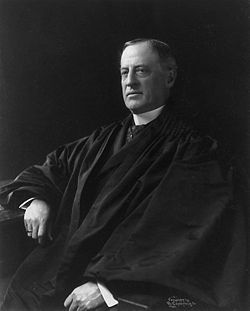
Three-term Republican George P. Wetmore retired and was replaced by Republican judge LeBaron Colt January 21, 1913.
| Party | Candidate | Votes | % | |
|---|---|---|---|---|
| Republican | LeBaron Colt | 32 | 82.1% | |
| Democratic | Addison P. Munroe | 5 | 12.8% | |
| Progressive | George W. Parks | 2 | 5.1% | |
| Turnout | 39 | 100% | ||
Both senators voting for Selling declared that they voted to protest a new system of nomination.


 French
French Deutsch
Deutsch





